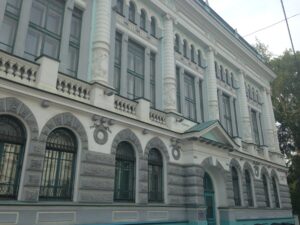On Friday, while working at the research library (pictured here) of Tomsk State University (TSU, or ТГУ), I discovered that one of the questions scholars have raised about pre-revolutionary Tomsk revolves around its seemingly large number of pro-monarchist, ultra-nationalist organizations.  For instance, A. P. Tolochko shows that Tomsk gubernaia had by far the largest number of pro-monarchist organizations in Siberia, and that the city of Tomsk itself likely had the largest number of individual members. If at the end of 1906, beginning of 1907 the Tobol’sk region had 1 such organization, the Tomsk region had 11, despite very similar economic situations in both parts of Western Siberia. [see A. P. Tolochko, “Territorial’noe razmeshchenie, chislennost’ i sotsial’nyi sostav chernosotennykh organizatsii v sibiri v nachal’nik XX v,” in Chelovok v Istorii, edited A. N. Zheravina et. al. (Tomsk: Tomsk University Press, 1999), 198-206.]
For instance, A. P. Tolochko shows that Tomsk gubernaia had by far the largest number of pro-monarchist organizations in Siberia, and that the city of Tomsk itself likely had the largest number of individual members. If at the end of 1906, beginning of 1907 the Tobol’sk region had 1 such organization, the Tomsk region had 11, despite very similar economic situations in both parts of Western Siberia. [see A. P. Tolochko, “Territorial’noe razmeshchenie, chislennost’ i sotsial’nyi sostav chernosotennykh organizatsii v sibiri v nachal’nik XX v,” in Chelovok v Istorii, edited A. N. Zheravina et. al. (Tomsk: Tomsk University Press, 1999), 198-206.]
Then on Saturday, I conducted an interview with one of the founding members of the Tomsk chapter of the Memorial Society, and I was struck again by Tomsk’s peculiarities. Tomsk had one of the first and largest chapters of Memorial, and succeeded in both placing a monument dedicated to, as it’s written on the monument, “the victims of Bolshevik terror,” and establishing a museum dedicated to the history and memory of Stalinist repression. Both the monument and the museum are at the very heart of the city. Very few Russian cities have been quite so comfortable with displaying reminders of Stalin-era repression.
So, is there something about Tomsk itself that makes it unusual?
Leave a Reply